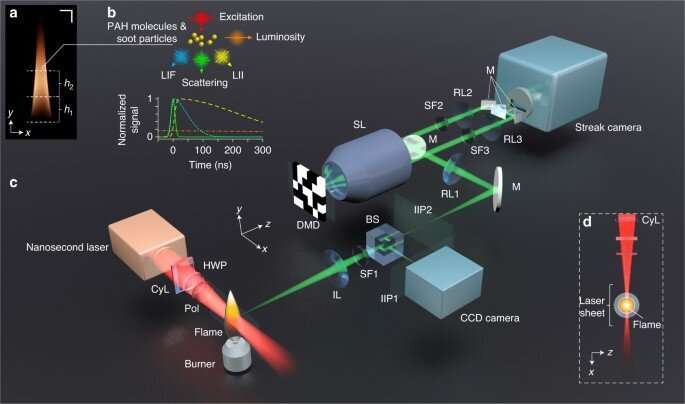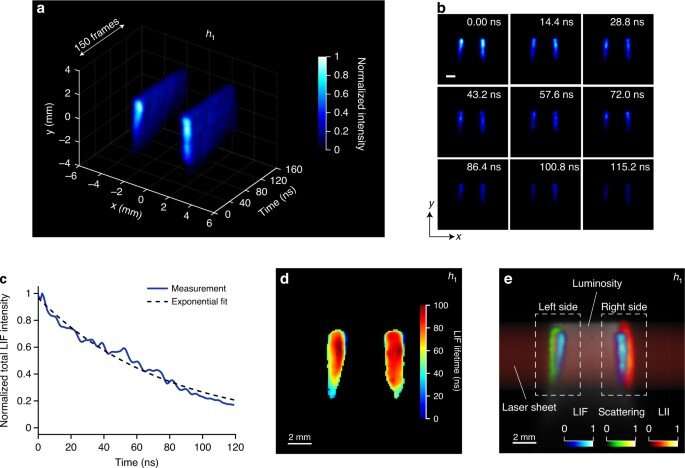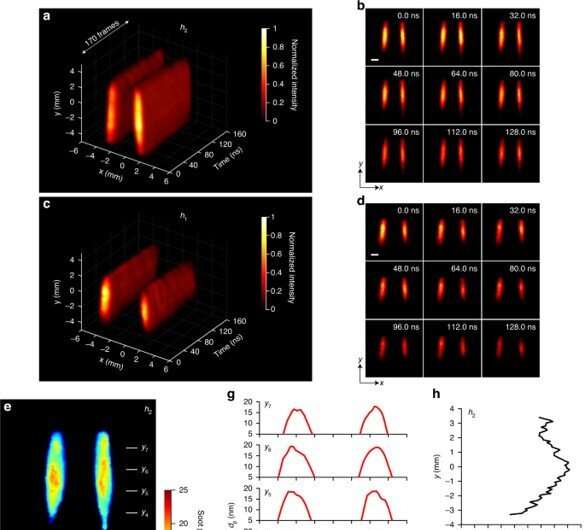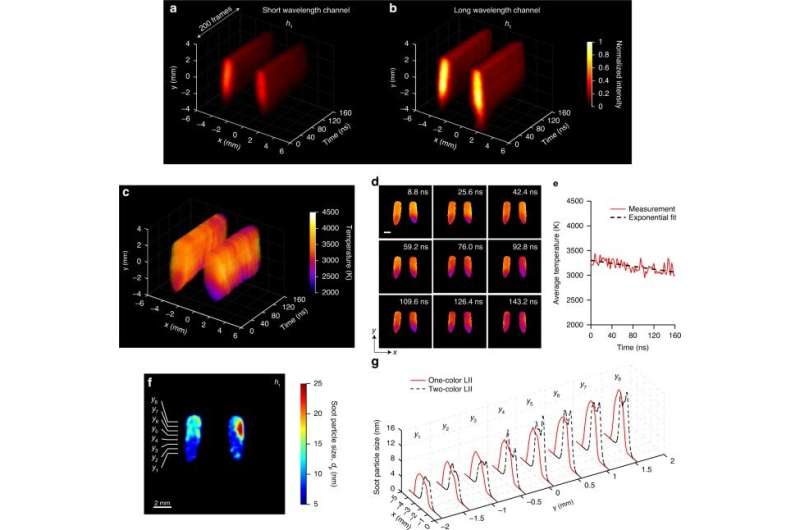March 6, 2023 feature
This article has been reviewed according to Science X's editorial process and policies. Editors have highlighted the following attributes while ensuring the content's credibility:
fact-checked
peer-reviewed publication
trusted source
proofread
Single-pulse real-time billion-frames-per-second planar imaging of ultrafast nanoparticle-laser dynamics

The soot produced by unburnt hydrocarbon flames is the second largest contributor to global warming, while also harming human health. Researchers have developed state-of-the-art, high-speed imaging techniques to study turbulent flames, yet they are limited to an imaging rate of million-frames-per-second. Physicists are therefore keen to obtain a complete picture of flame-laser interactions via single-pulse imaging.
In a new report published in Light: Science & Applications, Yogeshwar Nath Mishra and a research team at the Caltech Optical Imaging Laboratory, the NASA Jet propulsion lab, department of physics, and the Institute of Engineering Thermodynamics in the U.S., and Germany, used single-shot laser-sheet comprised ultrafast photography per billion frames per second, for the first time, to observe the dynamics of laser-flames.
The team noted laser-induced incandescence, elastic light scattering and the fluorescence of soot precursors such as polycyclic aromatic hydrocarbons in real-time, with a single nanosecond laser pulse. The research outcomes provide strong experimental evidence to support soot inception and growth mechanisms in flames. Mishra and the team combined a variety of techniques to probe the short-lived species in turbulent environments to unravel the mysteries of hot plasma, nuclear fusion and sonoluminescence.
The environmental and health impacts of polycyclic aromatic hydrocarbons (PAH)
Modern day hydrocarbons including kerosene, gasoline and diesel produce harmful emissions such as polycyclic aromatic hydrocarbons (PAHs) that contribute to poor health effects. Soot emissions have a large impact on the quality of human life due to its nanoscale size that can easily penetrate the lungs or bloodstream to cause health defects. While PAHs form precursors of soot particles that contribute to toxic carcinogenicity, their role is also significant in materials science due to their use as carbon nanomaterials.
The high energy efficiency, low cost and rapid production of the plasmonic nanoparticles have led to applications with excellent optical properties. Incidentally, about 70% of interstellar space is composed of carbonaceous particles, and soot formation from gaseous PAHs have remained a mystery in both combustion science and astronomy. In 2014, physicists first reported a method of compressed ultrafast photography (CUP) for single-shot 2D imaging, with an imaging speed of 70 trillion frames per second.
In this work, the researchers used laser-sheet compressed ultrafast photography (LS-CUP) technology as an experimental framework to observe laser-induced fluorescence of polycyclic aromatic hydrocarbons to determine primary particle sizes, for soot temperature mapping and light scattering applications. The engineers and physicists synergized planar imaging and compressed ultrafast photography (CUP) to view flame-laser interactions in real-time. They combined laser-sheet time planar imaging to explore a comprehensive experimental outcome, where the multi-channel capabilities of the network allowed the team to investigate qualities of the flame in real-time and explore high dimensional imaging.

Laser-sheet compressed ultrafast photography (LS-CUP) technology
During the experiments, the team examined a laminar, symmetric and relatively stable kerosene flame. They selected kerosene as a fuel due to its broad industrial and domestic applications and characterized the flame by using four optical signals and included time-gated cameras to collect a specific signal of interest.
Based on laser-sheet imaging, the scientists optically sectioned a 2D plane of a volumetric flame, where they extracted a 2D map of the species of interest and collected it on a camera thereafter, which was covered by screens to reduce turbulence. The imaging lens assembly projected the flame dynamics to two intermediate image planes separated by a non-polarizing beam splitter. The scientists selected different flame signals via dual operation of the LS-CUP technology to simultaneously image the two species.

Observing the polycyclic aromatic hydrocarbons (PAHs) laser-induced fluorescence decay in real-time
The research team sought new experimental insights to better understand the growth chemistry of polycyclic aromatic hydrocarbons; the molecular precursors of soot. Physicists had previously studied the spatially resolved, averaged 2D light-induced fluorescence of PAHs in flames and obtained time-resolved measurements.
Nevertheless, reports on single-shot, high-speed spatiotemporal imaging of polycyclic aromatic hydrocarbons were yet to be explored, which Mishra and colleagues conducted by exciting laser-induced fluorescence with a single 532-nm pulse. The researchers studied a combined view of the flame luminosity with polycyclic aromatic hydrocarbons, light induced fluorescence, soot-laser induced incandescence and elastic light scattering extracted from time-integrated images via three sequential measurements.
The team studied the time-resolved, one-color laser-induced incandescence (LII) after examining the evolution of soot and deduced the size of the soot particles from the LII signals via energy and mass balancing. They further obtained time-resolved two-color laser-induced incandescence as well as the soot temperature dynamics with two optical bandpass filters, which they simultaneously recorded with two channels via laser-shield compressed ultrafast photography. The accompanying temperature maps showed varied temperatures throughout the flame that was highest at the flame edges and lowest at the center and at the bottom of the flame. The researchers additionally observed elastic light scattering from soot particles in real-time.

Outlook for the new invention
Yogeshwar Nath Mishra and colleagues achieved the world's fastest single-pulse, real-time, 2D imaging of combustion with an unprecedented imaging speed of 12.5 Gfps, with a sequence depth of up to 200 frames via laser-sheet compressed ultrafast photography (LS-CUP). The imaging speed exceeded the existing high-speed rate in the Mfps regime, and the team used the new invention to explore active and passive imaging options. The work opens new paths for real-time ultrafast imaging of polycyclic aromatic hydrocarbon molecules via femtosecond pulses to gain new details to their origins.
These insights will shed light on the development of carbon-based nanomaterials and allow materials scientists and physicists to understand the fundamentals of combustion relative to jet propulsion. Broader research applications include using LS-CUP to examine sonoluminescence; a mysterious phenomenon in condensed matter physics, where the gradual build-up of sound in fluid can produce bubbles with a plasma temperature greater than 10,000 K that emit a light flash in tense of picoseconds.
By using the LS-CUP method, the team envision exploring ultrafast temperature sensing of sonoluminescence bubbles that have a broad scope of applications across condensed matter physics and as therapeutic strategies in the life sciences.
More information: Yogeshwar Nath Mishra et al, Single-pulse real-time billion-frames-per-second planar imaging of ultrafast nanoparticle-laser dynamics and temperature in flames, Light: Science & Applications (2023). DOI: 10.1038/s41377-023-01095-5
Liang Gao et al, Single-shot compressed ultrafast photography at one hundred billion frames per second, Nature (2014). DOI: 10.1038/nature14005
Journal information: Light: Science & Applications , Nature
© 2023 Science X Network





















